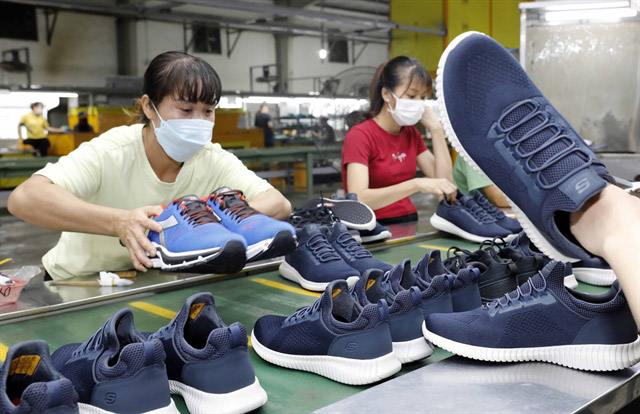

Vietnam’s textile, garment and footwear sectors aim to achieve a total export value of 77-80 billion USD in 2025 and 106-108 billion USD in 2030, according to the strategy for the development of Vietnam’s textile and footwear industry.

Illustrative photo (Source: VNA)
Hanoi (VNS/VNA) - Vietnam’s textile, garment and footwear sectors aim to achieve a total export value of 77-80 billion USD in 2025 and 106-108 billion USD in 2030, according to the strategy for the development of Vietnam’s textile and footwear industry.
Under the development strategy approved by the Government, for the long term, the garment, textile, leather and footwear sectors are still key export industries of the economy.
The sectors will continue to promote investment in the production of materials and auxiliary materials, as well as supporting industries.
They will encourage the production of fabrics from domestically produced yarn to reduce imports, and form a complete supply and value chain in the region.
For the leather and footwear industry, Nguyen Duc Thuan, Chairman of Lefaso, said domestic enterprises need to actively adapt to the requirements of the market and brands on sustainable development standards for products. They must reduce emissions in the production process, and increase the use of solar energy and highly sustainable products.
Also, according to the strategy, Vietnam’s textile and garment industry expects export turnover to reach 50-52 billion USD in 2025 and 68-70 billion USD in 2030.
The strategy also states that developing the fashion industry is considered a new direction. Accordingly, this sector will focus on developing designers, and raw material supply, production and distribution systems to form supply chains and create sustainable foundations for the development of Vietnam’s fashion industry as well as fashion centres in Hanoi and HCM City.
The strategy encourages enterprises to gradually switch their production methods to FOB (free on board) and ODM (original design manufacturer) to add value to products, and build a private brand to improve the competitiveness of the businesses and products.
Materials are the most difficult factor in the textile and garment industry. Therefore, to promote the development of the textile and garment supporting industry, the textile and garment industry strives to have a localisation rate at 51-55% in 2021 - 2025 and 56-60% in 2026-2030.
To achieve this goal, it is necessary to attract investment in the development of supporting industries and the production of raw materials and accessories for the textile and garment industry based on advantages in the free trade agreements Vietnam has joined.
The projects to develop the supporting industry and the production of raw materials and accessories should be built in regions with a number of textile and garment enterprises to reduce transport charges and production cost and improve competitiveness.
The strategy also mentions the role of State management agencies in encouraging enterprises to invest in producing fiber, yarn, textile and dyeing with advanced technology and connections with domestic garment enterprises.
This approved textile and garment development strategy will help form industrial parks with wastewater treatment areas to attract textile and dyeing projects. Now, the infrastructure for textile, dyeing and fabric production is still limited.
Domestic fabric production only reaches 2 billion metres per year, meeting 25-30% of the demand of the garment industry. Vietnam’s textile and garment industry currently must import 60-70% of the raw materials. Vietnam has joined many FTAs, creating conditions for textiles and garments to expand export markets with the tariff gradually reducing to zero.
According to Chairman of the Vietnam Textile and Apparel Association Vu Duc Giang, in the first quarter of 2023, the number of export orders decreased by 25-27% due to the decrease in global purchasing power.
Therefore, businesses can produce lower-value products, and diversify markets and products to keep production and promote growth.
Chairman of Vinatex Le Tien Truong said that many businesses now only ran 70-80% of production capacity due to a reduction in consumer demand. So, Vinatex is now focusing on raw material production more than garment production. The materials are always the first step in greening, creating a foundation for qualified materials as green requirements of the US and Europe.
Vinatex had organised the production of yarn products from recycled materials or organic materials. At the same time, the raw material production factories were equipped with solar power to meet green energy standards.
According to forecasts, the situation of Vietnam’s textile and garment industry in 2023 would be worse than in 2022. Therefore, businesses needed to follow the market's developments to have flexible solutions to ensure efficiency in production and business, as well as promote the export of goods, Truong said./.
Source: VNA
RANG DONG INFRASTRUCTURE INVESTMENT AND DEVELOPMENT JSC (AURORA IP)
Head office: Lot HC3, N2 Road, Rang Dong Textile Industrial Park, Rang Dong Town, Nghia Hung District, Nam Dinh Province
Northern Regional Office: HCO Building, 5th Floor, 44B Ly Thuong Kiet Street, Hoan Kiem District, Hanoi, Vietnam
Southern Regional Office: VTP Building, 2nd Floor, 8 Nguyen Hue Boulevard, Ben Nghe Ward, District 1, Ho Chi Minh City, Vietnam
Tel: +84 228 885 6886
Email: [email protected] - [email protected]
Fanpage: www.facebook.com/RANGDONG.AURORAIP